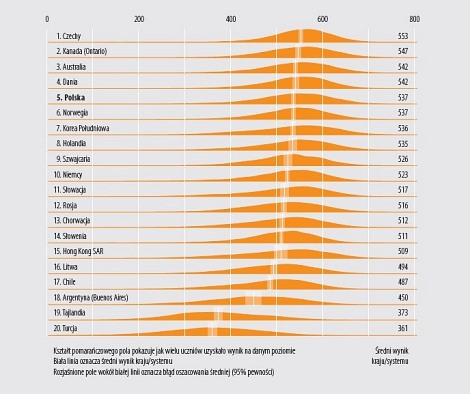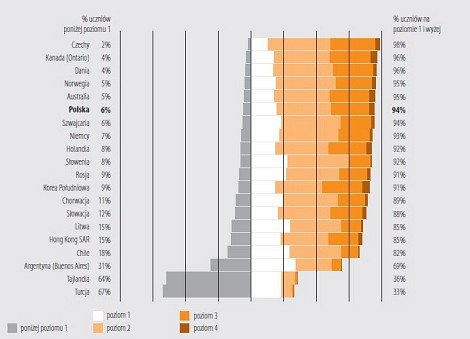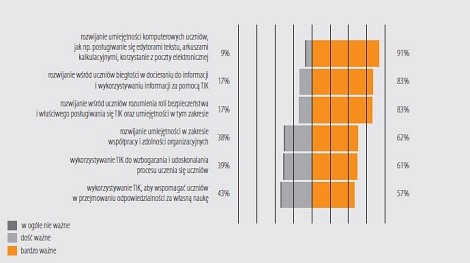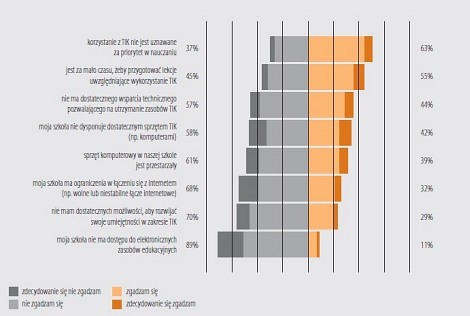Digital Reality of Polish lower secondary school students (ICILS 2013)
- Published on Friday, 21 November 2014 23:44
Excellent scores of Polish lower secondary school students. Second grade students of lower secondary schools at the forefront with some of the best results in the International Computer and Information Literacy Study (ICILS)The Educational Research Institute announced the results of ICILS study which measures the readiness of students to live in a "digital world". The study examined how lower secondary school students can investigate, create and communicate information using a computer.
.Polish students were in the forefront of the surveyed countries with some of the highest scores. They demonstrated competences comparable to their peers from Norway, Denmark, Australia and Canada. Only the Czechs, who scored the highest, were significantly better.
"Our 15-year-olds did very well, it may certainly be considered a success," says Kamil Sijko of IBE. "This does not mean, however, that everything was perfect. There is always room for improvement and in the study several such areas can be seen. A good example may be the item where as much as 30 percent of students could not provide an e-mail recipient, although they saw the email's header," he notes and adds that what surprised him most were the teachers. "It turned out that they intesively use computers in their private time, and very rarely in the classroom. So even though they realize that the computer is an important tool, very useful in everyday life, as many as 2/3 of them believe that using computer is not a priority in their lessons. As a result they use computers in the school less than their colleague-teachers from other countries.
The focus of the study and how it was carried out
The ICILS study was conducted in Poland in 2013. The study covered 2870 lower secondary school students from the second grade, 157 schools and 2,228 teachers.
The most important part of the study was computer-based test which was divided into two sections. The students had 30 minutes to do the test.
They also completed a questionnaire which helped to collect the data on student background characteristics, previous computer experience and attitudes towards ICT.
The teachers of the students that took part in the study also completed a special questionnaire, concerning, among others, the use of computers in the school and beyond, and their self-reported computer proficiency.
Data on the schools taking part in the study was also collected. School principals completed a questionnaire concerning, among others, computing resources and practices in the school related to the use of ICT in education.
Poland scores high In comparison to all the countries surveyed in ICILS, Polish students did very well. The variation of scores within the group of top twelve countries, which includes Poland, was very small.
 The level of computer and information literacy of students in the surveyed countries
The level of computer and information literacy of students in the surveyed countries
 Proportion of students at each level of the test (level 1: 407-492 points, level 2: 492-576 points, level 3: 576-661 points, level 4: 661 points or more) (poziom=level)
Proportion of students at each level of the test (level 1: 407-492 points, level 2: 492-576 points, level 3: 576-661 points, level 4: 661 points or more) (poziom=level)
In Poland, girls scored higher. The bigger the city the students lived in, the higher the average computer and information literacy level. Students of rural schools scored the lowest.
IBE researchers suggest that the level of computer and information literacy is strongly related to school grades in Polish language, mathematics and computer science, and an average score of the school in external lower secondary school examinations. The relationship was strongest between CIL and mathematics grades.
IBE experts say that the high scores of Polish students are more related to students' individual experience rather than to how their schools work or what the schools are like.
"Student's computer experience, socio-economic status of his/her family, and educational aspirations were more important," explains Sijko. "It should be noted, however, that students from rural schools, with lower competences, claimed that they acquired them in school more often. This may indicate that the school plays an important compensatory role in information and computer education in smaller towns," he says.
ICT in schools
ICILS results indicate that Polish schools, compared to other countries, have relatively modest technological infrastructure, even regarding the most basic resources - personal computers. The number of computers in a school is very weakly related to the number of students.
Students from schools in the smallest towns have the best access to computers. On average, there is one computer per six students. In every fourth lower secondary school computers are located in almost all classrooms.
Both principals and teachers admit that they rarely use information and communication technologies (ICT) for communication, eg. with parents or other schools.
The priority is to equip students with individual skills, and only further, to use modern technologies to facilitate the cooperation between pupils - in project work and in carrying out other tasks. Only 32 per cent of Polish students use a computer working jointly on a task, the average of all the surveyed countries being 40 per cent.
In Polish schools ICT is used most often during computer science classes (99 per cent.), and least frequently during physical education classes (42 per cent). New media also support the teaching of French, chemistry, history, physics, art, and education for safety - less frequently religion and mathematics.
 The importance of use of ICT for the achievement of different learning outcomes
The importance of use of ICT for the achievement of different learning outcomes
41 per cent of Polish teachers use computers in the classroom at least once a week - the percentage lowest in the 20 countries surveyed. On the other hand, when it comes to the use of computers in their private lives - Polish teachers are in the forefront.
This may the result of the attitudes of school principals who emphasize the importance of ICT, but, at the same time, give low priority to the implementation of concrete solutions in teaching.
Teachers themselves point to many barriers that prevent them from using new technologies in school. And the main barrier is not - as you might expect - limited infrastructure.
 Barriers in the use of ICT in teaching and learning
Barriers in the use of ICT in teaching and learning
Students use ICT every day, but at home
As is clear from the declarations of Polish students, most of them use a computer at home. 88 percent use for daily communication. Very often, the computer is used for entertainment, for example listening to music or watching films. It is rather less complex work that lower secondary school students perform on the computer - mostly they search for information and communicate with others.
Computer use by students in school or for educational purposes reflects typical tasks assigned by teachers - often the computer is simply a typewriter for essays (43 per cent).
"It is promising that high school students are aware of the potential of the new technologies and that they use them, for example, to manage their time," says Kamil Sijko. "As many as 44 per cent of students do it at least once a month, and it is a very high score compared to the average of 40 percent for other surveyed countries."







